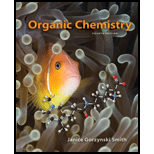
Concept explainers
(a)
Interpretation: The products formed from the treatment of benzoyl chloride
Concept introduction: The nucleophilic acyl substitution of acid chlorides involves two steps; that is the addition of nucleophile to carbonyl group, followed by the elimination of leaving group to give nucleophilic substitution product.
(b)
Interpretation: The products formed from the treatment of benzoyl chloride
Concept introduction: The nucleophilic acyl substitution of acid chlorides involves two steps; that is the addition of nucleophile to carbonyl group, followed by the elimination of leaving group to give nucleophilic substitution product.
(c)
Interpretation: The products formed from the treatment of benzoyl chloride
Concept introduction: The nucleophilic acyl substitution of acid chlorides involves two steps; that is the addition of nucleophile to carbonyl group, followed by the elimination of leaving group to give nucleophilic substitution product.
(d)
Interpretation: The products formed from the treatment of benzoyl chloride
Concept introduction: The nucleophilic acyl substitution of acid chlorides involves two steps; that is the addition of nucleophile to carbonyl group, followed by the elimination of leaving group to give nucleophilic substitution product.
Want to see the full answer?
Check out a sample textbook solution
Chapter 22 Solutions
Connect Access Card For Organic Chemistry
- Draw the products formed when phenol(C6H5OH) is treated with each reagent. Give an explanation. c. CH3CH2Cl, AlCl3 l. product in (c), then KMnO4arrow_forwardDraw the products formed when phenol(C6H5OH) is treated with each reagent. Give an explanation. a. HNO3, H2SO4 h. product in (a), then Sn, HClarrow_forward2. provide appropriate reagentsarrow_forward
- Nitromethane is reacted with ethyl prop-2-enoate with EtO-Na+, EtOH 3 equivalents to give the product X(C16). X then reacts with H2/Raney Ni to give the product Y(C14), which in turn reacts with Na to give Z (C12). Indicate which products X, Y and Z are.arrow_forwardWhat product is formed when D-Gulose is treated with a. CH3I, Ag2O b. The product in (a), then H3O+ c. The product in (b), then C6H5CH2Cl, Ag2Oarrow_forwardExplain why methyl trifluoroacetate, CF3CO2CH3, is more reactive than methyl acetate, CH3CO2CH3, in nucleophilic acyl substitution reactions.arrow_forward
- When 2-pentene is treated with Cl2 in methanol, three products are formed. Account for the formation of each product (you need not explain their relative percentages).arrow_forwardDraw the products formed when phenol (C6H5OH) is treated with following set of reagents. [1] CH3CH2Cl, AlCl3; [2] Br2, hνarrow_forward1. You have an alkyl halide and the product has a thiol group without an alkyl, what is the reagant? 2. What is the reaction of disodium sulfide and Na2S, what is its product? 3. You have a thiol compound that reacts with sodium hydroxide, what do you get? 4. You have an oxyrane reacting with sulfuirc acid and methanol, what do you get? 5. Have an alkene reacting with Br, what do you get?arrow_forward
- Give the products formed when Benzaldehyde and Benzoic Acid are treated with the given reagents. g. LiAlH4 then H2O, H+h. 2 moles CH3OH, H+i. CH3MgCl, then H2O, H+arrow_forwardwhen an nitriles are treated with 1)NaOH,H2O/2)H3O+ , Explains what happens ?arrow_forwardWhat carboxylic acid is formed from each alkyl halide on treatment with [1] Mg; [2] CO2; [3] H3O+?arrow_forward

 Organic ChemistryChemistryISBN:9781305580350Author:William H. Brown, Brent L. Iverson, Eric Anslyn, Christopher S. FootePublisher:Cengage Learning
Organic ChemistryChemistryISBN:9781305580350Author:William H. Brown, Brent L. Iverson, Eric Anslyn, Christopher S. FootePublisher:Cengage Learning

